Back in 1932, following on from Leitz’s success with the Leica, Carl Zeiss introduced a competing interchangeable lens rangefinder: this was the Contax. Unlike the Leica, it used a bayonet mount and a vertically running metal shutter. Following the war, much of the tooling for the Contaxes was shipped back east. Zeiss ended up split, with the eastern bits merging into Pentacon. The western part of the company carried on as Zeiss Ikon, producing a revised version of the Contax II and III until the early sixties.
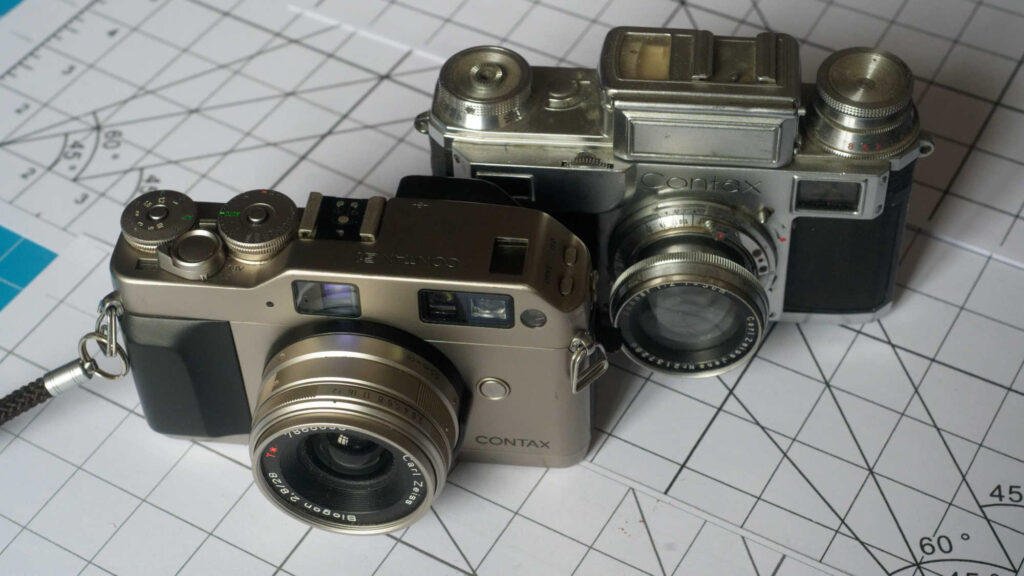
In the 70s Leica collaborated with Minolta, Zeiss Ikon also built bridges with Yashica, leading to the release of the first Contax RTS camera using the ‘Contax/Yashica’ (C/Y) bayonet mount. The Cameras and lenses tended to be made in Japan by Yashica (which was later absorbed by the ceramics giant Kyocera), with branding, lens designs and QA processes from Zeiss. The collaboration continued (outliving the one between Leitz and Minolta), leading to a fair few of Contax SLRs. In 1994 it also led to the introduction of a modern autofocus take on the interchangeable lens rangefinder camera. This was the Contax G system.
Contax G
The Contax G could never claim to be the most versatile 35mm rangefinder system – Leica’s M mount has far more scope and the range of lenses and system components is incomparable.
It does have a claim to be the most technologically advanced of the interchangeable lens rangefinder cameras. Other M mount cameras matched the built-in winder and vertical shutter, but none ever ventured into autofocus.
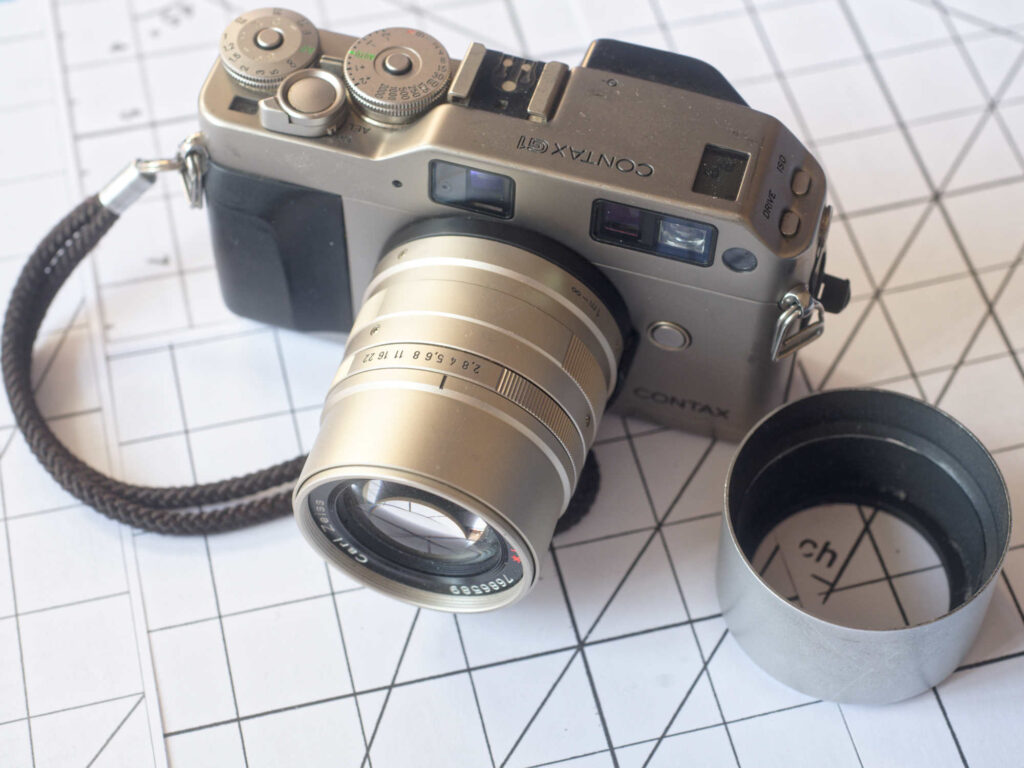
While relatively cheap for an interchangeable lens rangefinder camera, the Contax G1 was an expensive bit of kit when it was released. It seems to have often been sold as a kit, with the dedicated flashgun, 28 and 45 and 90 lenses. The titanium lens hoods are rather gorgeous but were costly extras when the system was new.
Lenses
Although the Contax only ever had 7 lenses (only 6 of which were AF), those lenses are nothing to sniff at. The standard 45mm f/2.0 Planar has been described as just about the sharpest 35mm lens ever.
The range of lenses extended from the Hologon 16mm f/8.0 manual focus lens, through to a Biogon 21mm f/2.8 and then a Biogon 28mm f/2.8, Planar 45mm f/2.0 and Sonnar 90mm f/2.8. When the G2 was released, a Planar 35mm f/2.0 was added, along with a Vario-Sonnar 35-80 zoom. G1 cameras required a slight upgrade to use the 35 (indicated by a green label inside the film compartment), but were unable to use the zoom as it required the camera body to have 7 contacts in the mount.
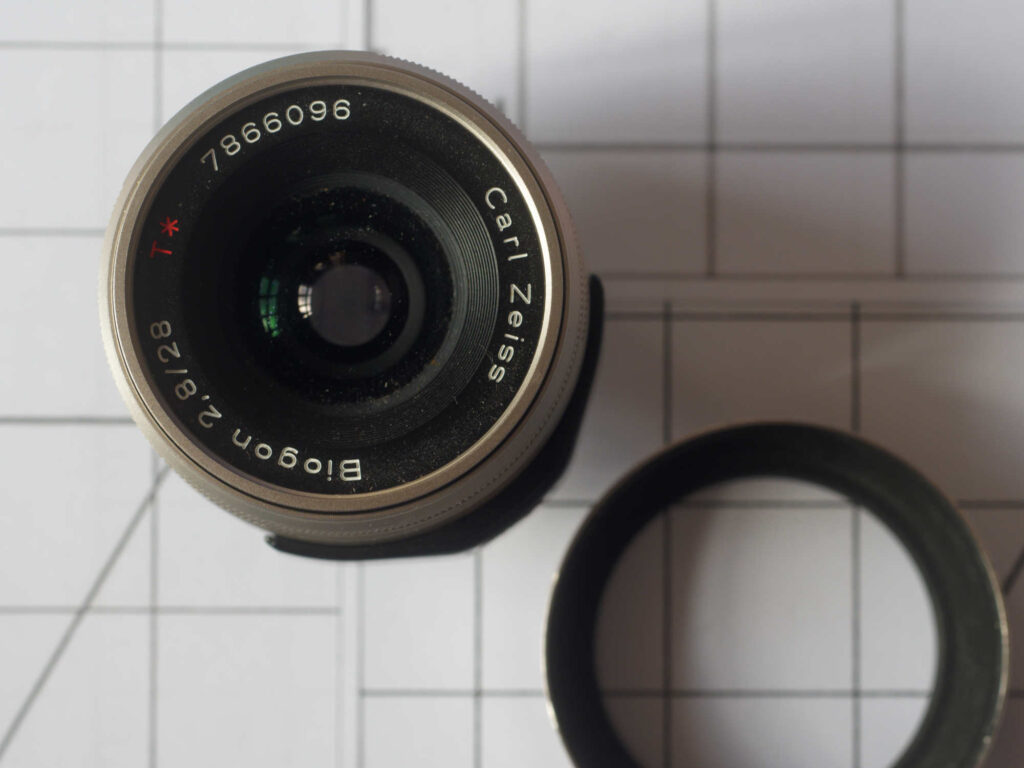
The G system uses a four-flange bayonet. It secures the lenses using a breach-lock system which means that the focus drive coupling from the body and the electrical contacts don’t have to deal with rotation and wear.
The diaphragm of each lens is purely mechanical. Although there is no electrical control of the lenses from the body (the only control being the focus screw-drive) there are a whole bunch of electrical connections. The lenses actually have 9 contacts, but the G1 only has pins for 5 (the later G2 used 7). No apertures are shown in the viewfinder. However, aperture data can be printed between frames by some of the data-backs. Information about the selected aperture may be passed to the camera via the contacts. I suspect that focus information is also checked.
None of the AF lenses have focus rings (something that rather complicates using the lenses on digital bodies), instead manual focus is fly-by-wire and operated from a dial at the top right corner of the top-plate. The dial can be easily turned by a thumb.
Focusing the lens via a wheel on the body harks back to the old rangefinder Contaxes and a desire to produce a new technological take on an old feature may have influenced design choices. A block is shown in the viewfinder with an indication beneath it of whether the camera thinks the lens is focused too close or too far away based on what it sees through the electronic rangefinder.
Something in and around the bayonets of the lenses can leave a greeny-blue, slightly oily deposit on the mount which can be seen when changing lenses. I think this comes from the lens side as it also appears on non-Contax adapters that the lenses are attached to when using them on digital. The other oddity is that when lenses are off the camera they appear to not open up properly/fully – this is simply because the markings on the lens barrel move as the lens is breech-locked into place.
Slightly disappointingly, although the diaphragms are fully manual, they only feature 8 blades – it should have been so easy to make round multi-bladed apertures for lenses that don’t need to stop down in an instant.
As well as the G lenses, Kyocera produced a GA-1 adapter that would allow C/Y lenses to be used on the G cameras – in effect you use the camera’s digital rangefinder to gauge the distance and then transfer that to the lens manually. It has to be said this adapter is rare and not cheap on the second-hand market..
The G1
The camera is a sleek titanium champagne-coloured block. It isn’t pretty-pretty, but it has an uncompromising elegance and sense of strength. Think one of those top Heptathletes.
It features a passive electronic rangefinder with a base of around 28mm, autofocus, automatic winding and rewinding. The people who worked on the Contax brand seem to have been quite conscious of the needs of photographers, so the aperture priority automatic exposure offers exposure compensation, automatic bracketing and exposure locks. When the light drops, the camera shines a red beam from its AF illuminator.
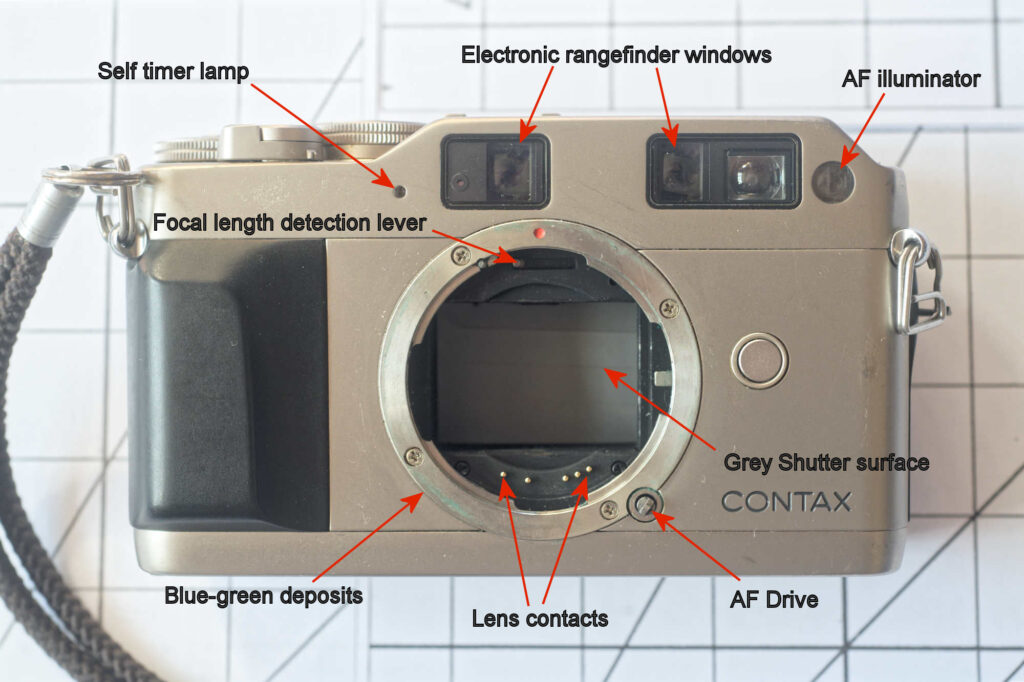
The lens release button is the only bit of this camera that disappoints from a build point of view, it is less than positive it its action and the little tab that anchors the breech-lock in place seems quite insubstantial.The camera meters from the grey front surface of the focal-plane shutter
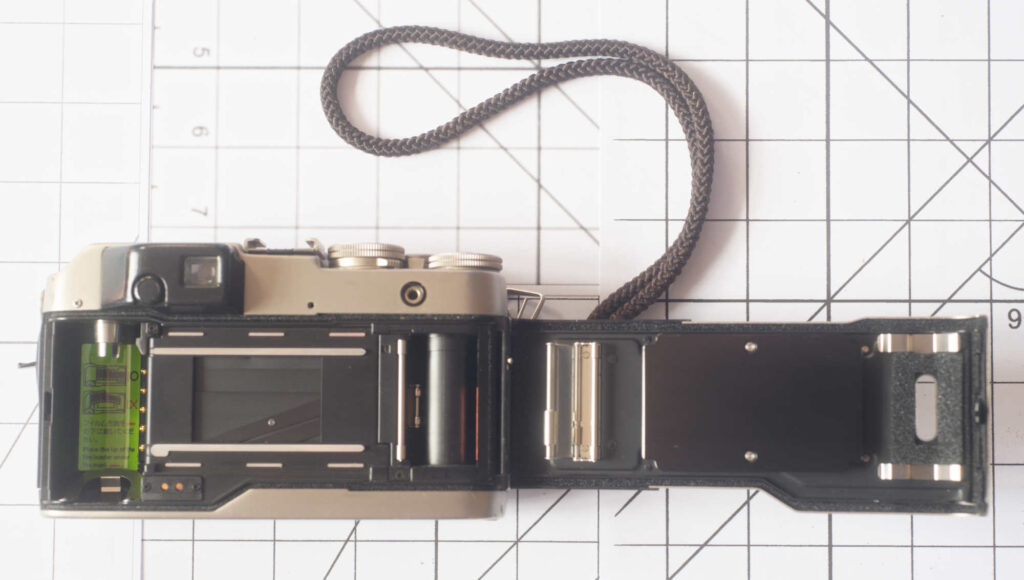
Note the green label in the film compartment showing that this camera has been updated to use the 35mm lens released with the G2. Also in the film chamber are the contacts to read the DX coding on films. Just right of that near the base are contacts for the data-back and above that, the protruding eyepiece with dioptre compensation dial. Further along the back of the top-plate is the screw-in electrical cable release socket (do not try to attach a mechanical plunger type!). The pressure plate is huge. Film movement across the gate is measured by a tiny IR sensor at the right-hand end of the top film ‘glide’.
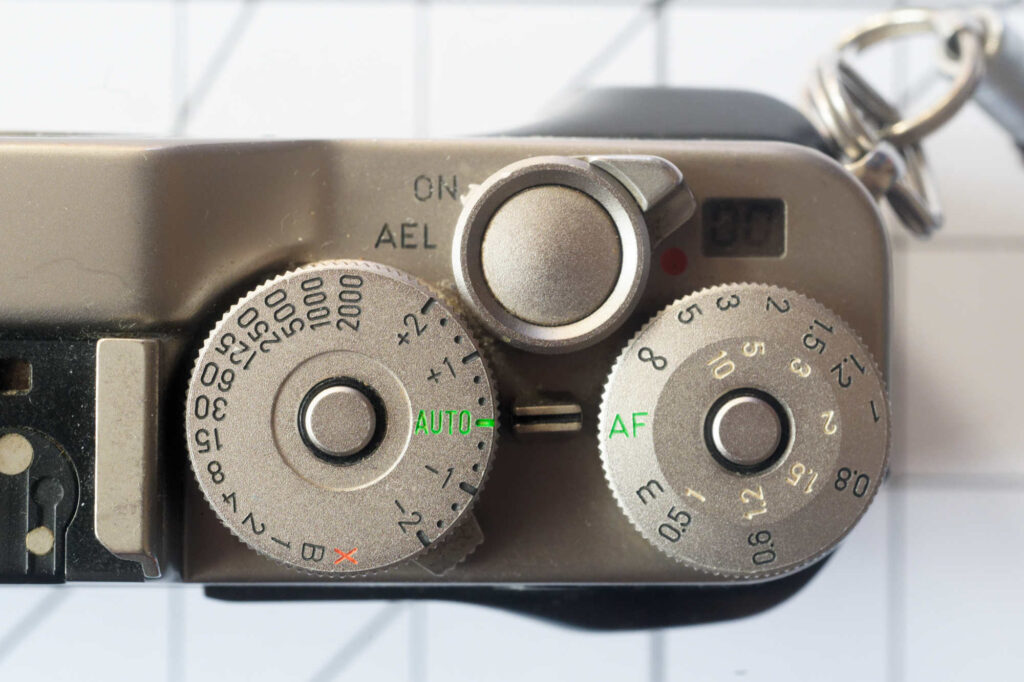
On top surface of the top-plate you can find a hot shoe with dedicated contacts to allow communication between the flash and camera body. The shutter speed dial allows setting of speeds up to 1/2000, with Auto options and compensation settings in 1/3 of a stop increments. The focus dial shows distances in feet and meters. Both dials have a lock button to stop accidental movement between automatic and manual settings. You can also set the on/off switch to lock exposure on a half-press. Beneath the shutter speed dial (with a tab visible near to the ‘minus’ compensation marks), is the control for automatic bracketing, giving a choice of half or full stop increments.

Visible on the left side is the little LCD info panel, which shows drive mode, ISO and the distance in feet if you are set to manual focus. Down the slope are buttons that allow you to set single, continuous, bracket exposures or self timer and to set/override the ISO speeds. On the side are the flash PC socket and the back catch, which folds out and twists to open.
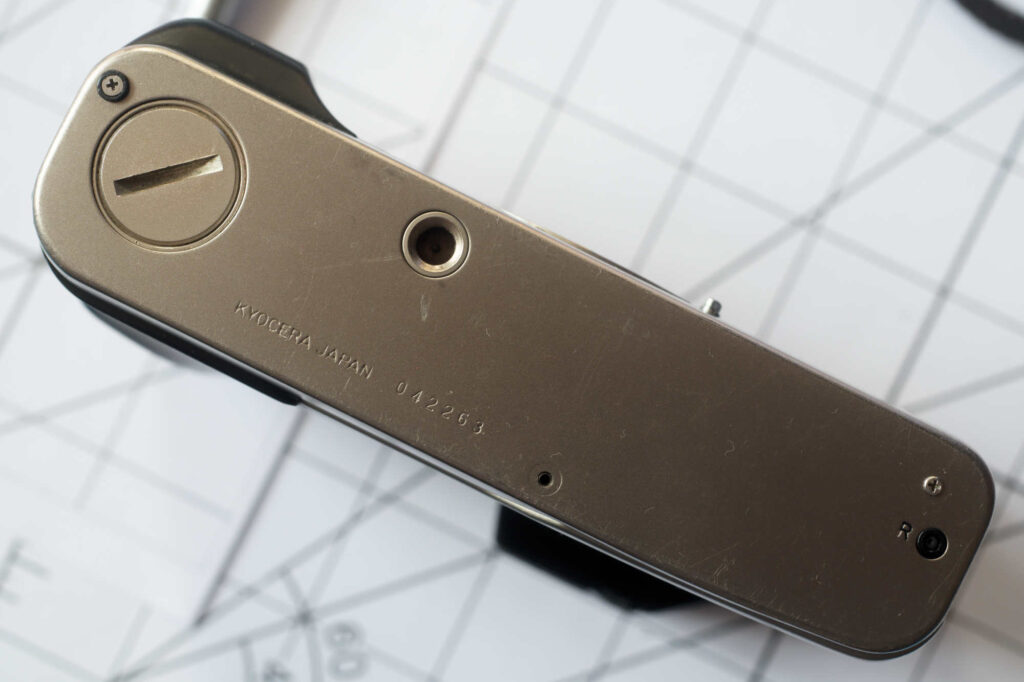
As well as the standard controls, the camera offers some custom functions, allowing you to set the way that the autoexposure lock works, bracketing order and whether the leader is left out of the cassette after rewinding.
Viewfinder
The built-in viewfinder automatically frames lenses from 28 – 90 mm. A lever in the mount automatically zooms the viewfinder when lenses are mounted to show the appropriate field of view. The 18 and 21 mm lenses were supplied with supplementary viewfinders.
For closer shots, the viewfinder will compensate for parallax, cropping the viewfinder to reflect bits of the left and top of the frame that won’t make it into the picture.
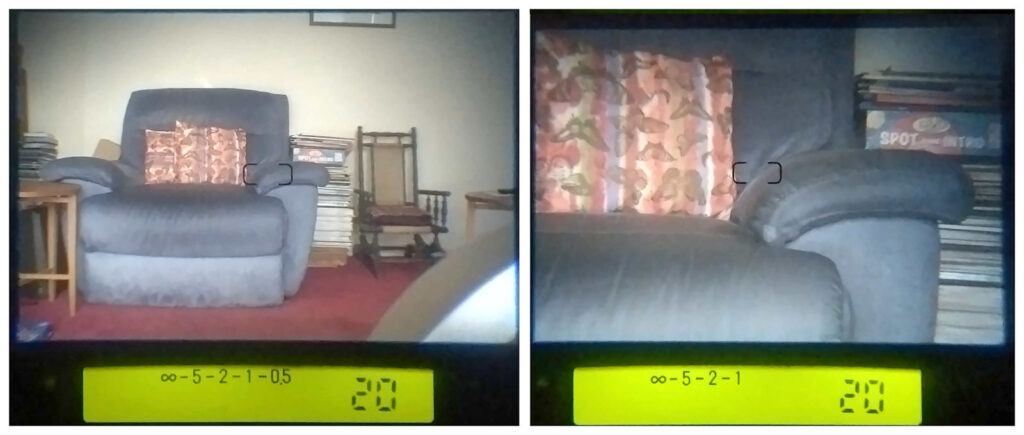
Note that you can see the lens hood of the Biogon in the 28 mm shot, while the 90 mm shot appears to have adjusted for parallax. As the distance scales confirm, the 90 doesn’t focus as close as the 28.
The zooming/cropping viewinder does mean that you don’t get the advantage of seeing what is just outside the frame. As when using an SLR, you have to rely on keeping the other eye open to cope with awareness outside the frame.
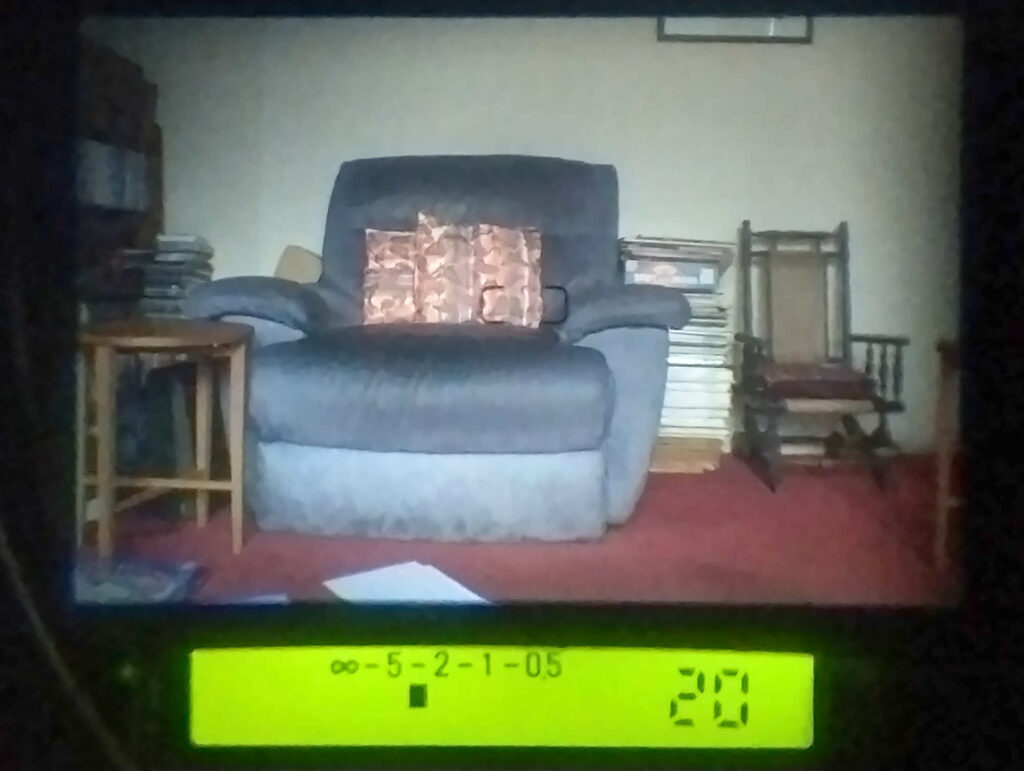
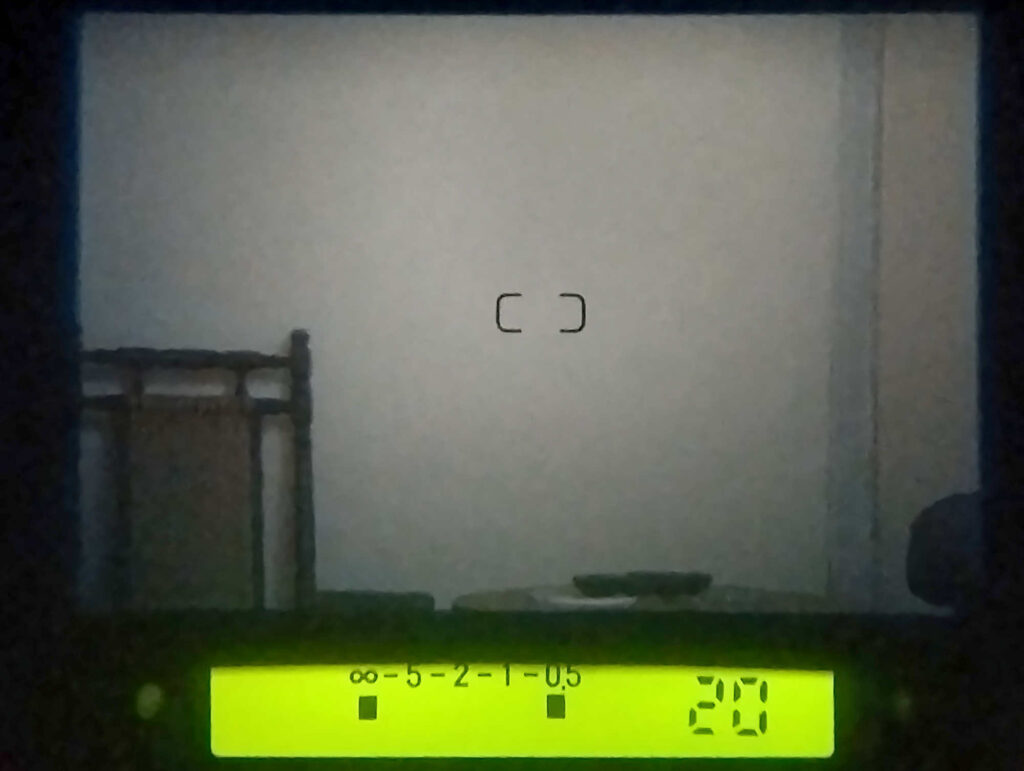
When the passive AF system cannot work out the distance (in this case because of lack of contrast at the centre of the frame), it shows ‘blobs’ at each end of the focus scale – in effect throwing up its arms in surrender. It is these sort of instances that the active AF system of the G2 should handle better, but some people still report AF issues with the G2.


The downside
Unfortunately, sometimes the darn camera just won’t shoot – it thinks it knows the right distance to the subject, it focuses the lens but then won’t fire the shutter. I suspect that the problem is to do with electrical connections in the mount or in the lens breech lock system and that some confirmation message that the camera is expecting is not getting through. When this happens, I find that if I undo the breech mount, wiggle the lens on the mount to seat the pins and do the breech lock up again, the problem often disappears. If they had designed the pins slightly differently and not used a breech lock, it is possible that the pins being dragged across the lens contacts would make better contact. Maybe I just need to find a better contact cleaner.
Another issue that I’ve encountered on my G1 and which seems to also occur on other examples is a shutter issue.
There seems to be an issue with the shutter unit that can lead to the shutter not opening – leading to a random blank frame (you can hear a slight difference when the shutter doesn’t open properly before the camera winds on). I’ve seen this put down to ‘magnets’, but I find that if the shutter is thoroughly exercised before loading a film (for instance by switching to continuous and firing off a really long burst), I get less blank shots – which suggests to me that inactivity and lubrication may be a factor. This process reduces the number of blank shots on a roll, although it never eliminates it. The best I’ve had is a single blank frame on a roll of 37 (the G1 is quite good a squeezing an extra frame out of a film). 5 is about average for my camera.
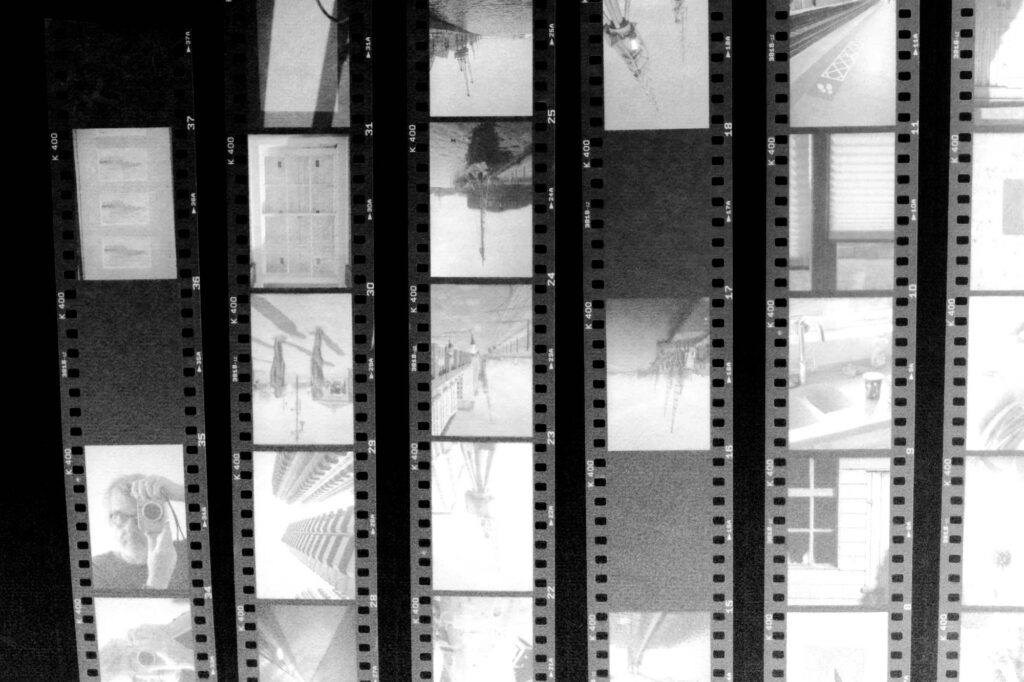
My own G1 Has some missing screws in the base – I suspect that someone has investigated an intermittent connection from the battery compartment and managed to lose some of the screws along with the little grommets that they sit in.
Pictures

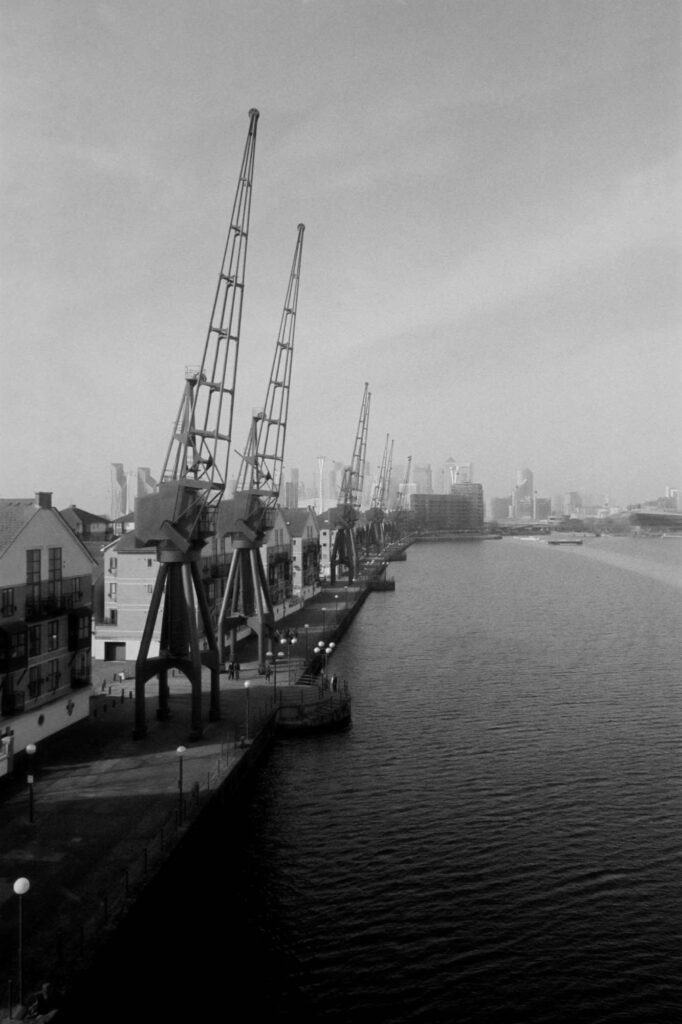
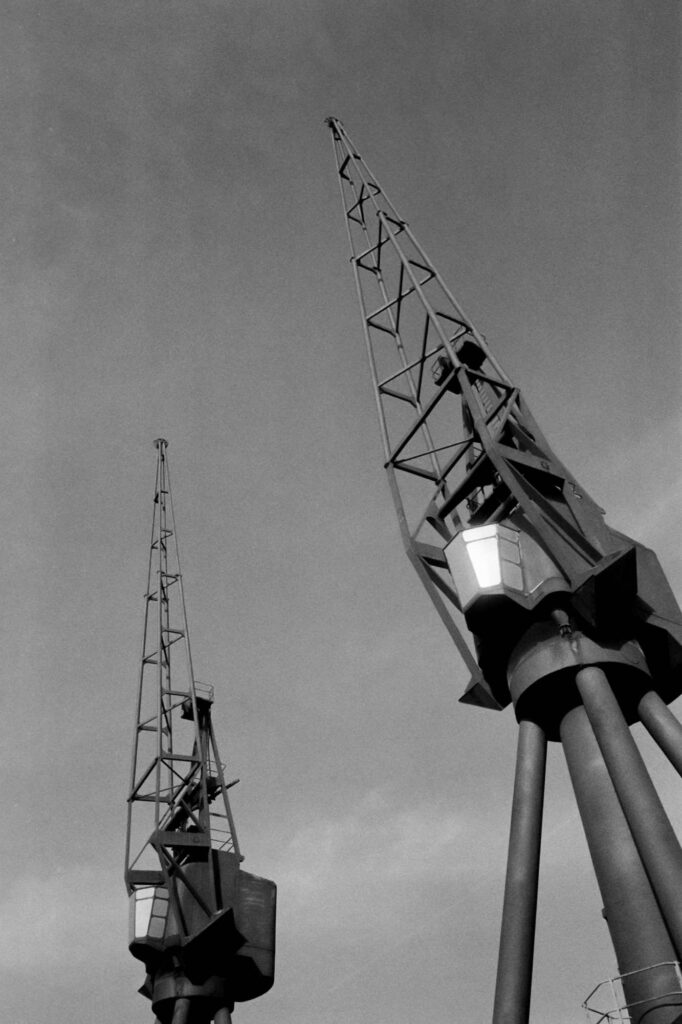
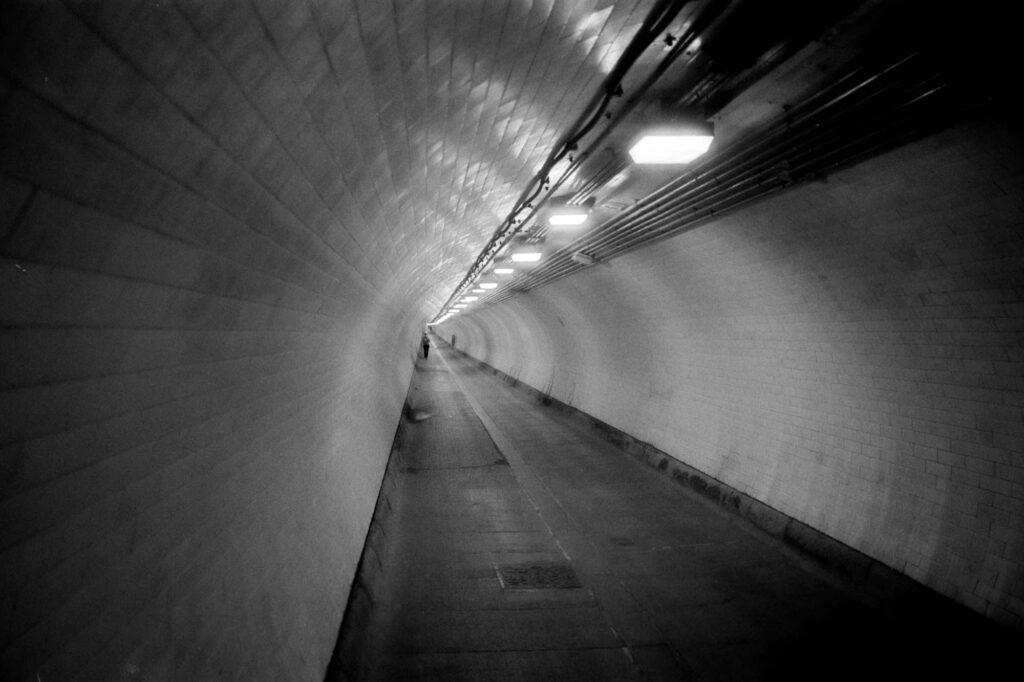


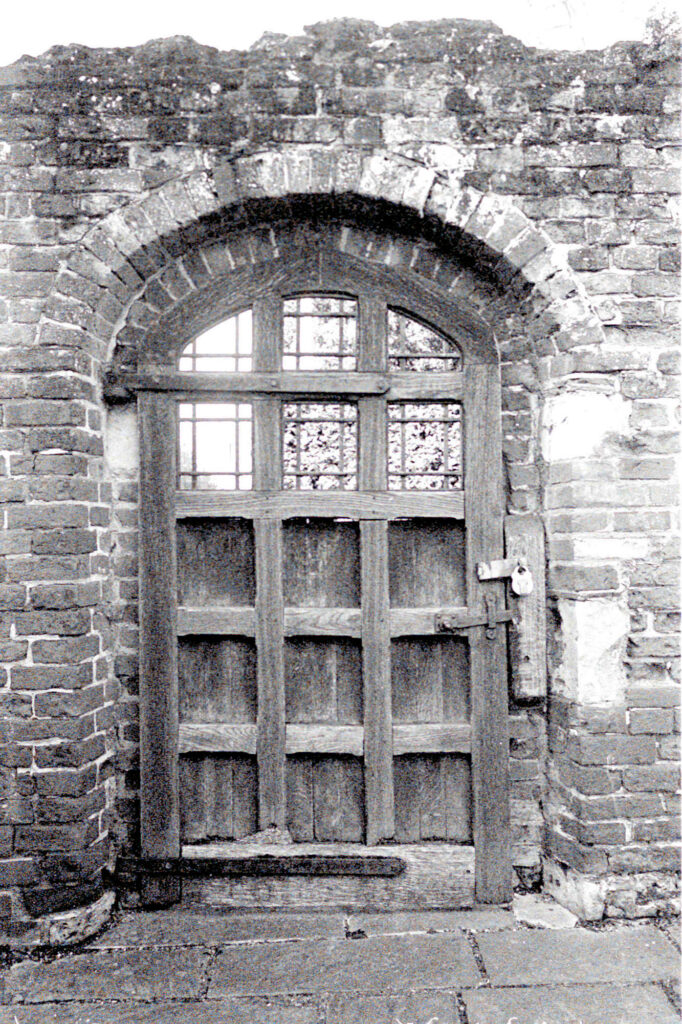
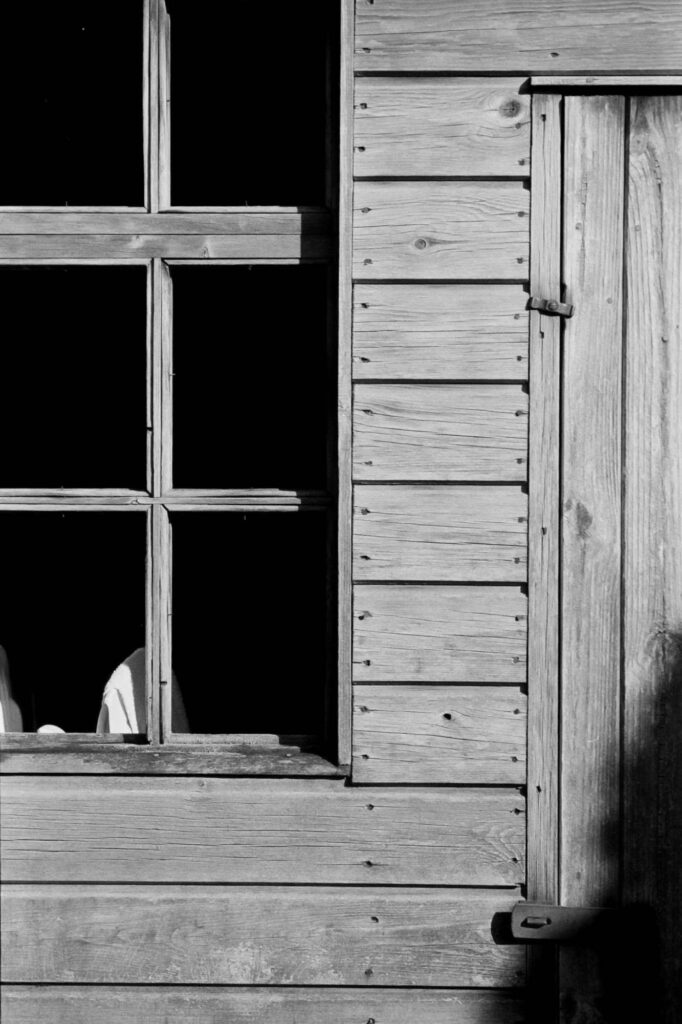
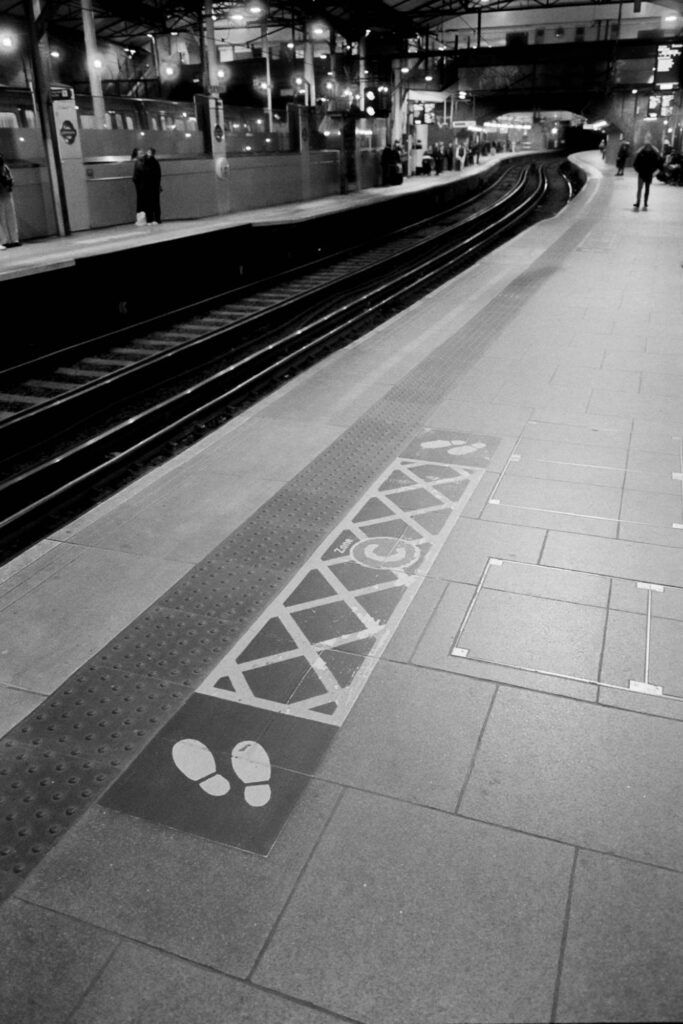
In use
I like the viewfinder. It protrudes from the back of the camera (giving nose relief) and uses an arrangement of prisms, presumably as part of its zooming tricks. I confess I do find myself putting my eye to the wrong bit of the viewfinder as the dioptre wheel is directly behind where you would expect a straight-through viewfinder. Due to the screw-drive autofocus, the camera is not as unobtrusive as traditional rangefinders, although the shutter itself is reasonably quiet, as is the winding mechanism… but I don’t think I’d get away with it in a church for a wedding shoot.
The body feels lovely in the hand. The titanium finish is incredibly tough and has worn well. Mine just shows the odd scuff here and there.
The Contax gives me the ability to use a genuine wideangle and a short tele, all in a compact body. The ability to shoot a 28 on a 35mm compact is not that common.
The Contax G1 has all the controls you could require as a photographer and it gives a feeling of great confidence, but far too often, when I go to press the shutter, the camera stops me – and for me that is an issue.
It is a lovely bit of kit. With fewer camera over-rides it could be ideal – but it isn’t. My little Auto S3 isn’t as wide, but also offers an exceptional lens. On top of that, It is very compact and quiet and will always trip the shutter when I press the shutter release (providing I’ve wound it on). For a 28 of comparable size, my Konica Wide 28 seems to offer more reliable AF.
I’ll probably never part with my G1, because it is such a beautiful instrument, but I can’t label it a joy forever.
Postscript
Two years after the G1 was released, Kyocera produced the updated G2. It had extra bells and whistles and a shutter that went to 1/6000. They moved the focus wheel to the front of the camera (very retro for the Contax RF crowd). The G2 has an active IR element to its AF system as a backup to the passive rangefinder and was available in black as well as the champagne finish. Expensive though the G1 is, the G2 is more desirable and more expensive on the second-hand market.
The G2 was released in 1996. In a few years the digital Tsunami would wash everything away. There never was another G model, not even a digital one. In 2005 Kyocera, like Konica Minolta, walked away from camera manufacture. A sad loss.
Share this post:
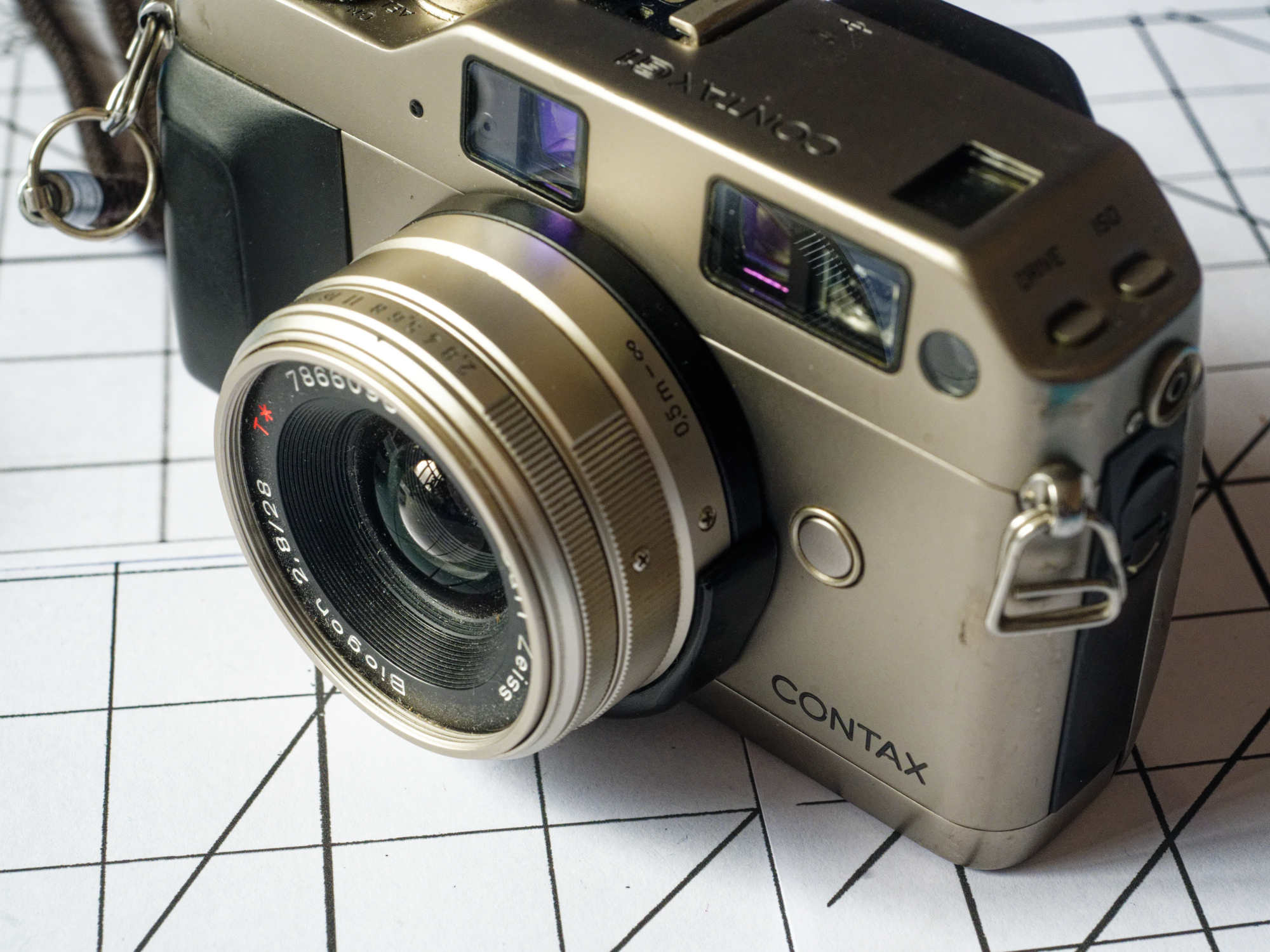
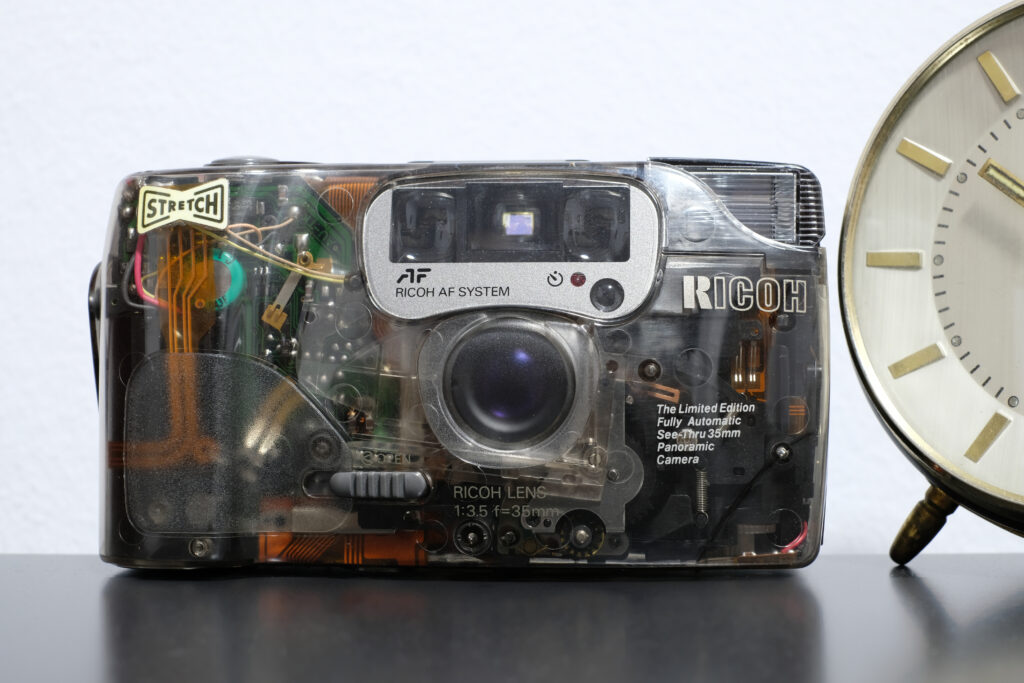
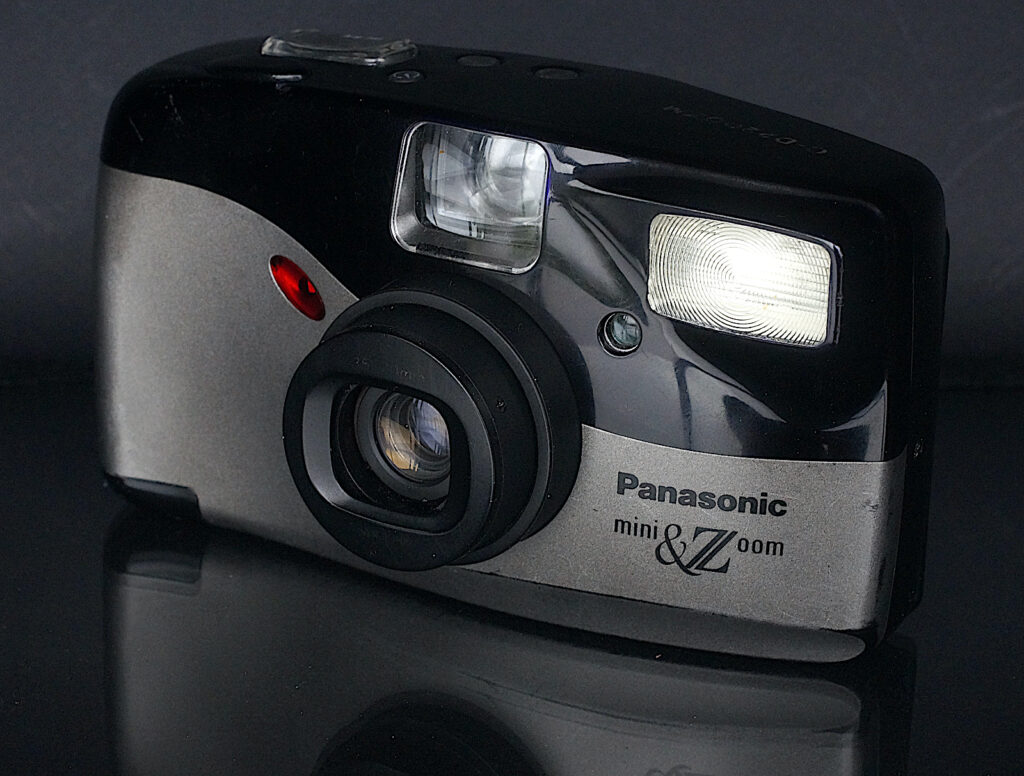
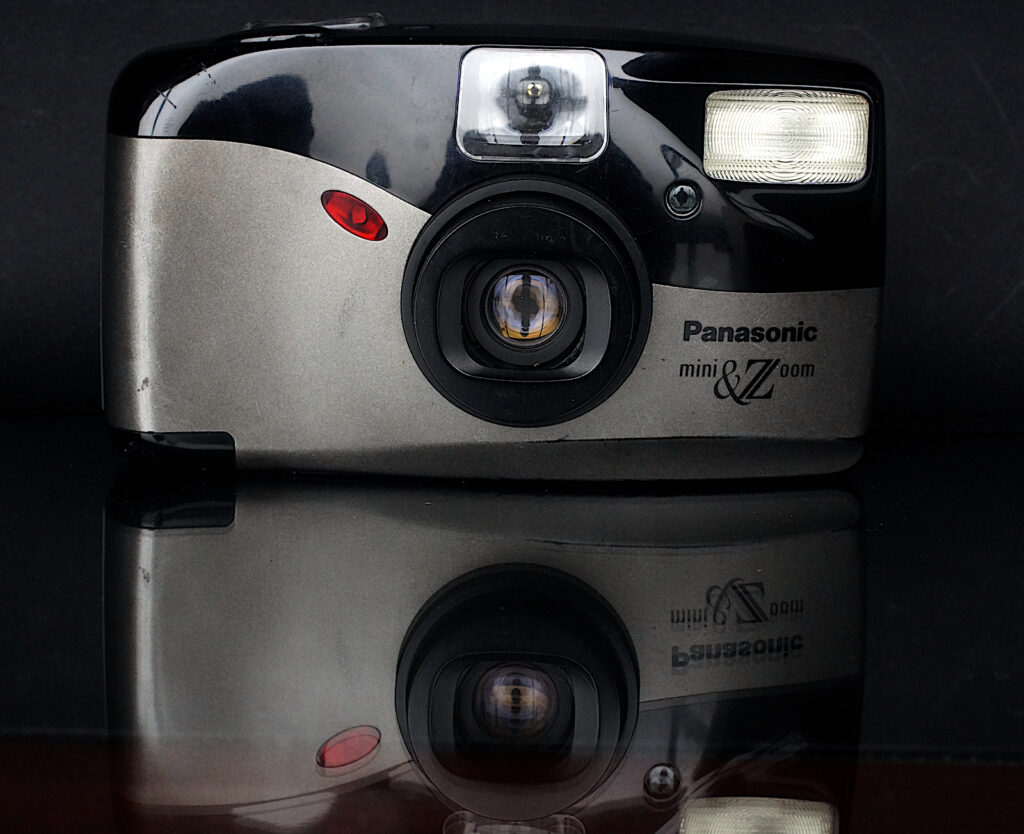
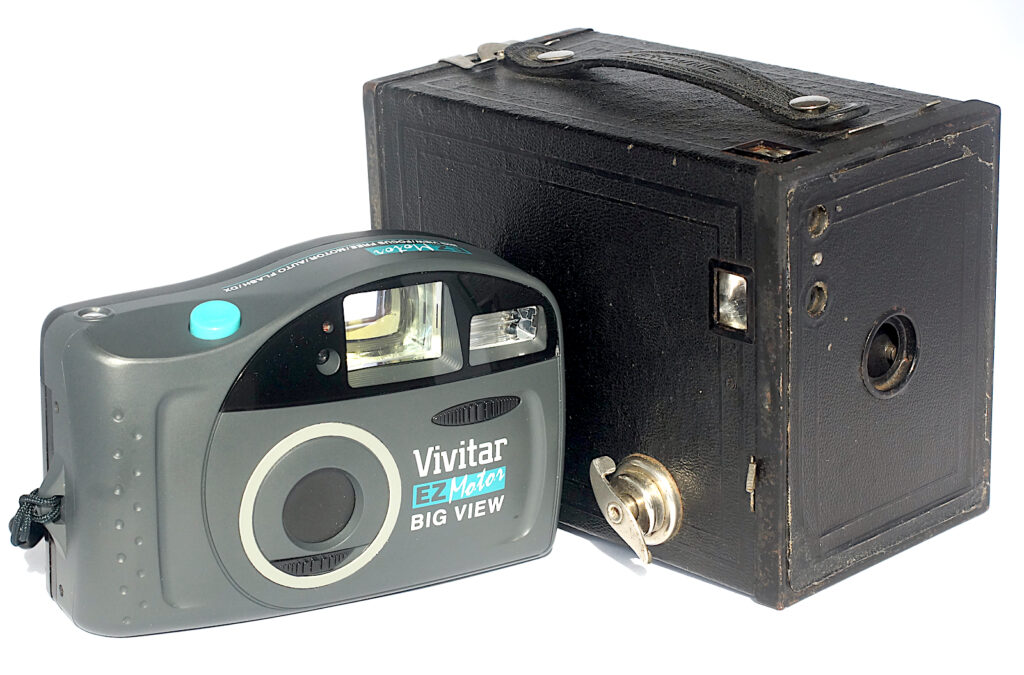




Comments
Ibraar Hussain on Contax G1 – A thing of Beauty…
Comment posted: 25/04/2025
I’ve never had a G1 but as you probably know I was shooting with a G2 for about 14 years. That was reliable in every condition I threw at it - never let me down.
Only the 90mm Sonnar was a pig.
I stupidly sold my G2 and now regret it as there’s nothing like it except the G1.
I was thinking of buying a G1 was what I’ve read about it is only to be confirmed by what you’ve written - so I won’t be. The G2 is way beyond my budget.
Ah man, I’d love to shoot the 45 and 21 again.
But there’s nothing else like this camera - there’s no 35mm RF type camera with AF and interchangeable lenses.
The G2 solves all the problems of the G1 and besides that it has been said to have a larger brighter finder and other advancements
Thanks again
Comment posted: 25/04/2025
Comment posted: 25/04/2025
Comment posted: 25/04/2025
Comment posted: 25/04/2025
Geoff Chaplin on Contax G1 – A thing of Beauty…
Comment posted: 25/04/2025
Comment posted: 25/04/2025
Jonathan Leavitt on Contax G1 – A thing of Beauty…
Comment posted: 25/04/2025
The great thing Contax does is put the focusing motor on the camera, and not on the lens, which makes the lenses much more compact. If today’s digital cameras did the same thing, their lenses would not be so enormous because they would not need a motor in every lens. The absurd size of auto focus lenses on today’s digital cameras is one of the things that keeps me using the rangefinder focus M11.
Jan K from Austria on Contax G1 – A thing of Beauty…
Comment posted: 25/04/2025
Gary Smith on Contax G1 – A thing of Beauty…
Comment posted: 25/04/2025
Tony Warren on Contax G1 – A thing of Beauty…
Comment posted: 25/04/2025
Dann Walker on Contax G1 – A thing of Beauty…
Comment posted: 26/04/2025
I have two G1s, bought new when they came on the market mid-'90s. Actually, at one time I had four, the latter two bought in the '00s when digital took over the market and film cameras were being flogged off for cents on the dollar. Eventually I sold two to a Japanese collector who offered me a crazy price and I grabbed the cash. Also the 45/2.0 Planar. The cameras I don't miss. The '45 I do, in fact I kick myself mentally when I think about having parted with it - it was the best darn 'standard' I've owned, nothing else ever came close to it, not even the legendary old f/AI/AIS Nikkor 50/2.0. (I have four of those nifty fifties, but let's not go there now...)
My two remaining G1s function as good as the day I got them. One works perfectly, but the other occasionally refuses to auto-rewind film and I have to use a toothpick and push the small button on the bottom plate, which usually does the trick. That or it's a black film loading bag to yank out the film. I then reload the camera and it goes on shooting. And usually rewinds okay the next time. Most exasperating, this - even infuriating! But I put up with it, the G1 is that sort of camera. Quirky. Quixotic. Always a joy and a delight to use.
Without the '45 I use a Biogon 28/2.8, which makes lovely color negatives and B&Ws with luscious creamy mid-tones. On the second G1 goes a Planar 35/2.0, almost as good as the legendary '45 but a little wider. I've yet to find another '45 at the price I got for mine originally, and a price I can afford for its replacement. So I make do.
I respectfully disagree with someone's comment that the Sonnar 90/2.8 is crap. Either it's not, or I lucked in and bought a good one. The basic problem with this otherwise beaut lens is it focuses erratically and you have to be spot-on with putting it exactly on that part of your subject you want sharp. Otherwise it wanders all over the place.
In our sad digital-everything age film cameras have taken a far-off second place, but they still have a role to play in photography. In June I'll go to Malaysia, Sarawak, Brunei and Sabah on one of my regular three-month forays to Asia. In my home darkroom fridge I have about 60 rolls of long-expired film I want to use up, so I'll fill up a few K-ration metal cans with plastic cassettes and beg for a hand inspection at Melbourne Airport when I fly out. Otherwise I plan to travel by car or bus so X-rays won't be a problem. A good lab in Kuala Lumpur will process all my films before I fly back to AUS.
And what when I've used up all my old 35mm film? Not sure, really. What I do know is my two G1s will stay with me until they (or I) are no longer able to function. The Gs are just that sort of camera...
Best from DANN in Melbourne.
Comment posted: 26/04/2025
Comment posted: 26/04/2025
Comment posted: 26/04/2025
Scott Ferguson on Contax G1 – A thing of Beauty…
Comment posted: 26/04/2025
Thanks for a very thorough look at the G1. I have a G2 that I bought in a bit of a splurge about 3 years ago, and while I admire the design and the very high quality of the build and especially the highly regarded glass, I found it hard to love as a camera system. I thought that a high end camera that had top quality auto exposure and auto focus would make shooting gorgeous photographs easy. As it turned out, I would occasionally get good photos, but a lot of my results from the G2 were not all that great. And because everything was automated, I wasn't really engaged in making the creative and technical decisions so my photos didn't get better. I just kept getting more of the same. It was what I might call my 'banter years' of photography when I was kind of flying blind in terms of what would make a good photo and just relying on shooting enough to get lucky now and then. Everything changed last summer when I started shooting with a couple of older all manual cameras that had world class optics (Leica and Hasselblad), but nothing electronic. I started with similarly bad results -- again I was wrongly assuming I'd get better photos because I was using a famous camera -- but because I was so much more intimately involved in every element of making a photo on those cameras, and I had no excuse for bad results based on the equipment, which was world class, I started learning how to get better. I've recently gone back to the G2, and while I don't think it will replace my M3 as my go to 35mm, I can really appreciate the wonderful glass and think it's a great piece of engineering design. My photos with the G2 are much much better now after I've started learning how to shoot photographs from the ground up.
Comment posted: 26/04/2025
Comment posted: 26/04/2025
Comment posted: 26/04/2025
Comment posted: 26/04/2025